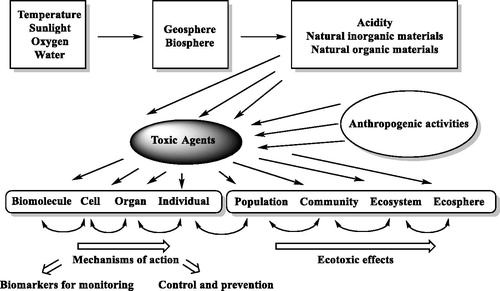Ecotoxicology is a multidisciplinary research area in which biologists, chemists, geologists, statisticians, and computer modelers study the toxic effects of environmental agents on biological populations, communities, and ecosystems. Environmental toxicology, a related field, investigates the effects of toxic agents on individual organisms, organs, tissues, cell types, organelles, and biochemical reactions. The Journal of Environmental Science and Health, Part C (JESH-C) aims to publish outstanding scientific review articles and original research reports presenting important and timely subjects in the fields of ecotoxicology and environmental toxicology.
Articles providing novel and relevant mechanistic insights related to the toxicity of natural and manmade materials present in the environment are of special interest to JESH-C and its readers. Deeper mechanistic understandings of how toxic agents affect biological systems adversely may contribute to the development of better methods for control or remediation and improved biomarkers for exposure (). In 2016, JESH-C published a review by Liyanage et al.[Citation1] describing the toxicology of freshwater cyanobacteria. The authors found an association between chronic kidney disease of unknown etiology in humans and the presence of harmful cyanobacteria in drinking water which, along with other types of data, utilized the detection of cyanotoxin biosynthesis genes as biomarkers for the presence of harmful algal species.
Combinations of anthropogenic and non-anthropogenic processes influence the distribution, mobilization, chemical conversions, and deposition of toxic agents in the environment. These factors also influence the modes of exposure to hazardous agents that biological systems will experience and the magnitudes of those exposures. Mishra and Bharagava[Citation2] included perspectives of this type in their review of hexavalent chromium in the environment, along with mechanistic insights associated with the ecotoxic effects of chromium VI on microbes, plants, animals, and humans. Similarly, the ecotoxic effects of arsenic were presented in an article by Jha et al.[Citation3], together with a comparison of municipal water treatment methods used to prevent or minimize exposure to arsenic based on its chemical and physical properties.
The ecotoxicology of engineered nanoparticles was reviewed by He et al.[Citation4] emphasizing the interactions between biological systems and nanomaterials (i.e. nano-bio interactions) and the physical and chemical interactions of nanomaterials in the environment (i.e. nano-eco interactions). Like the case for many organic compounds used industrially, phthalates detected in the environment are typically considered to have been deposited there as pollutants. However, in the current issue of JESH-C, Zhang et al.[Citation5] present an insightful review describing the non-anthropogenic generation of phthalate derivatives in the environment by biological systems along with their toxic effects.
The Editorial Board of JESH-C invites excellent review articles presenting novel and relevant mechanistic insights related to hazardous agents that cause environmental harm.
References
- Liyanage HM, Arachchi DNM, Abeysekara T, Guneratne L. Toxicology of freshwater cyanobacteria. Journal of Environmental Science and Health, Part C. 2016;34(3):137–168.
- Mishra S, Bharagava RN. Toxic and genotoxic effects of hexavalent chromium in environment and its bioremediation strategies. Journal of Environmental Science and Health, Part C. 2016;34(1):1–32.
- Jha SK, Mishra VK, Damodaran T, Sharma DK, Kumar P. Arsenic in the groundwater: occurrence, toxicological activities, and remedies. Journal of Environmental Science and Health Part C Environmental Carcinogenesis & Ecotoxicology Reviews. 2017;35(2):84–103.
- He X, Fu P, Aker WG, Hwang HM. Toxicity of engineered nanomaterials mediated by nano-bio-eco interactions. Journal of Environmental Science and Health Part C Environmental Carcinogenesis & Ecotoxicology Reviews. 2015;2(6):564–542.
- Zhang H, Hua Y, Chen J, Li X, Bai X, Wang H. Organism-derived phthalate derivatives as bioactive natural products. Journal of Environmental Science and Health, Part C. https://doi.org/10.1080/10590501.2018.1490512 (in press).

